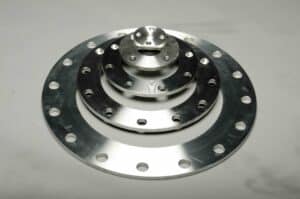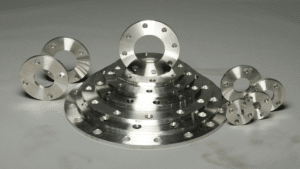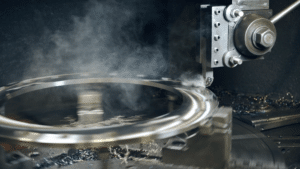When ordering pipe flanges and parts, it’s best to be as specific as possible. Include details such as:
1: Size Nominal Pipe Size (NPS)
The nominal pipe size of the connecting pipe is defined by the flange size (NPS). The NPS does not always correspond to the flange inside diameter. B16.5 is for .5″-24″ NPS flanges, and B16.47 is for 26″-60″ flanges. API stocks flanges ranging from .5” to 202”.
2: Pressure Class
This specifies the flange’s pressure-temperature rating, which is required for all flanges and covered by ASME B16.5. Classes such as 150#, 300#, 600#, 900#, 1500#, and 2500# are examples.
3: Type
The application determines the type of flange, with the most common being a Weld Neck (WN), Slip On (SO), Threaded (Thd), Socket Weld (SW), or Lap Joint (LJ). Reducing Flanges (RED), Long Weld Necks (LWN), and Stub Ends (SE) are a few more.
4: Facing
The sealing gasket is seated on the flange face, which serves as the contact surface. Different types of flange facing and surface finishes (RMS) are defined by ASME B16.5 and B16.47. Raised Face (RF), Ring-type Joints (RTJ), Flat Face (FF), Large Male (LM), Large Female (LF), Large Tongue (LT), and Large Groove (LG) are examples of common facing options.
5: Pipe Schedule
This only applies to non-standard flanges such as socket welds, stub ends, orifices, and weld necks where the flange bore must match the pipe. Pipe schedules used today range from SCH 5S to XXS.
6: Standard
A set of uniform specifications created by a professional organization, like the American Society of Materials Testing and Materials (ASTM) or the American Society of American Engineers (ASME), is referred to as a “standard” or “specification.” The material requirements for groupings of material grades like A182 (ASTM) / SA182 (ASME) or B564 (ASTM) / SB564 (ASME) are outlined by these authorities.
7: Material
Materials are frequently referred to by their trade names (Alloy 304/304L, for example). However, the most popular and widely used method of designating a material is with UNS numbers (UNS S30400/ S30403).
PRIMARY ALLOYS WE STOCK AT API INTERNATIONAL:
- Aluminum Series:
- A2011, A2024, A2017, A5052, A5056, A6061, A6063, A6463, A6082, A7075
- Copper Series:
- 3600, 3604, 3771
- Plastic Series:
- Delrin, POM, Lexan, Nylon 66, Nylon 6, PEEK, PP, PE, Acetal
- Rubber Series:
- EPDM, Neoprene, Buna-n, Viton
- Titanium Series:
- Grades 1-28
- Steel Series:
- Carbon Steel:
- A105, A36, A516-70, A572-50, Other Carbon Steel Available Upon Request
- Stainless Steel:
- 300 Series:
- 303, 304, 304L, 316, 316L
- 400 Series:
- 420J2, 430, 434, 442
- 300 Series:
- Carbon Steel:
- Special Metals:
- Hastelloy, Inconel, and Incoloy, Duplex 2205, Super Duplex 2507, Chrome Steel, Alloys, or their equivalents
These details are key to ordering the correct pipe flanges. If you’re replacing an existing flange, refer to the specifications stamped on the existing flange. Otherwise, you will need to provide some or all of the following details when you submit your order request.
Choose the Appropriate Flange Connection Type
What connection type do you require? Most pipe connection types are intended for specific jobs and may not be interchangeable. Specify your connection method or the intended application for the flanges you purchase.
The most common flange connection types are:
- Slip-On or Ring
- Blind
- Weld Neck
- Threaded
- Lap Joint
- Socket Weld

Measure to Determine Appropriate Flange Size
Measure the outside diameter (O.D.)—across the flange from one outside edge to the other. Then, measure the center hole of the flange—the inside diameter (I.D.)—which correlates with the pipe size.
Know the number of necessary bolt holes and the bolt circle diameter—measured from the center of one bolt hole to the center of the bolt hole directly across from it. If you use a reducing flange to connect a larger pipe with a smaller pipe, you will need pipe diameter measurements for both pipes you wish to connect. Consider dimensional tolerances to determine permissible limits in measurement differences.
Get the Appropriate Pressure Class
Flanges aren’t selected by physical measurements alone. The required pressure class or pressure-temperature rating helps determine which flanges are required. Pressure class and measurements can be related: The higher the class, the larger the outside diameter and bolt holes. The thickness of the flange also increases as size and pressure rating go up. Choosing a flange with a higher pressure rating (but not a lower one) may be acceptable, as long as the other flange dimensions and specifications match.
Other Considerations for Pipe Flange Orders
- What flange material do you need? Steel, stainless steel, ductile iron, aluminum—your required material most often matches the pipe material. Material can affect weldability, pressure rating, corrosion resistance, and use.
- What standards must your flanges meet? Do you need flanges that meet the specifications for American Water Works Association (AWWA), ANSI-style, DIN (metric) flanges, or other standards?
- Does the country of origin matter? Import flanges can be a more cost-effective solution, but may not meet the requirements for domestic infrastructure projects. The new Build America; Buy America (BABA) law, which went into effect on May 14, 2022, governs domestic preferences for Iron and Steel, manufactured goods, and Construction materials for infrastructure projects that use federal dollars for funding.
- Consider any additional fittings or accessories necessary. Are gaskets, stub ends, spacers, or other fittings required?
- If we do not stock the options you need, let us know. Our Custom Machine Shop allows us to manufacture or modify products to meet specific customer needs.
- Order lead time differs between products and an estimate can be given when the order is placed. If you have a deadline, let us know so we can work to fulfill your order in time.
Explore our catalog and contact us with questions or to submit an order or inquiry—we’re available to help answer your questions, help you decide which flanges are appropriate, or provide a quote for your order.
For more information about ordering flanges and pipe system components, explore our Resource Center.





